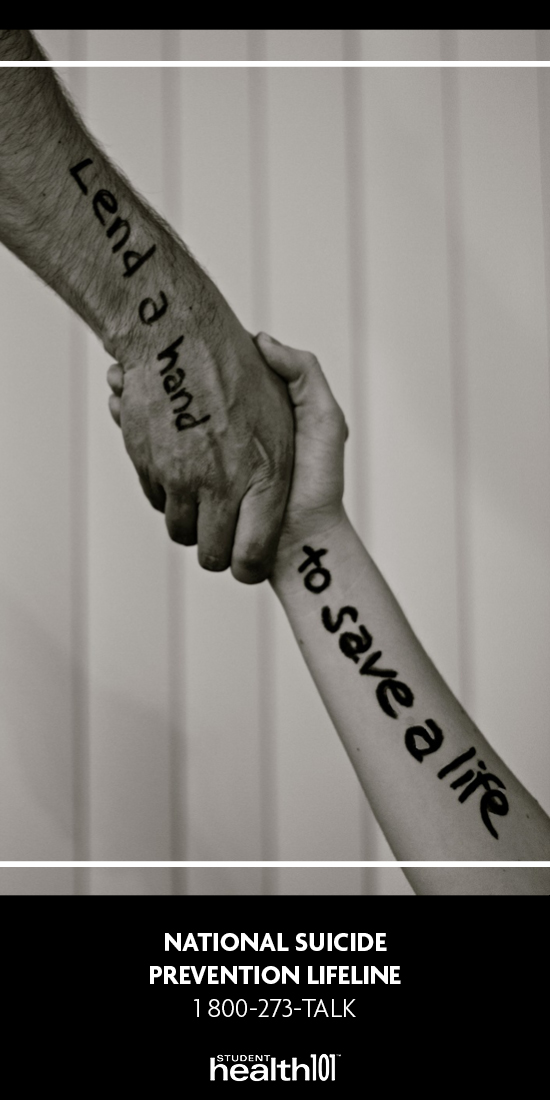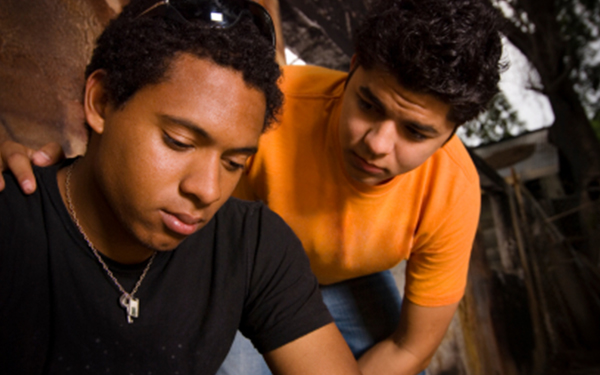Suicide prevention
What to do when a friend needs help
 |
Have you ever worried about a friend or family member whose emotional struggles seem to be getting worse? Maybe they were behaving recklessly or hinting at self-harm. Being a student means joining a community. Within that community, it is likely that someone you know will be seriously affected by mental illness or contemplate suicide. Almost all of us would want to help—but how?
studentvoice

Students trust their peers
Here’s why you could play an important role in suicide prevention:
- Two out of three students who disclose suicidal thoughts tell a peer first, research shows.
- Many students are willing to accept that role. Six out of ten students are interested in receiving information about how to help others in distress, according to the American College Health Association.
- Schools across the country are affected by suicide deaths and emotional health issues that can precede them. In a 2014 survey by the ACHA, about one in three students reported feeling so depressed at some point in the last 12 months that it was difficult to function.
Why is it so hard to talk about suicide?
The biggest barrier to talking about suicide is fear and discomfort. “We know that because of stigma, it can be hard to talk about suicide. Some people may even find it scary,” says Marian Trattner, coordinator of the Be That One suicide prevention program at the University of Texas, Austin. The concerns she hears from students match the survey responses collected by Student Health 101:
- By asking my friend about suicide, what if I put the idea in their head?
- I might say the wrong thing and cause harm.
- This is not my business. My friend has a right to privacy.
- It could ruin our relationship.
- What if I come off as judgmental or stigmatizing?
- What if my friend has to leave school or hospitalized?
- I might be overreacting.
- I don’t know if these behaviors actually indicate a risk of self-harm.
Active bystanders make a choice to help
At many schools and in many communities, “active bystander” suicide prevention programs are designed to help students overcome these barriers. Helping another person involves three steps, says Trattner:
- Notice something is wrong.
- Choose to respond.
- Take action.
Your support can be either:
- Direct: e.g., talking to the person you’re worried about
- Indirect: e.g., talking to or involving another person or resource
What to do if you see suicide warnings
Call 911 or seek immediate help from a mental health provider when you hear or see any of these behaviors:
- Someone threatening to hurt or kill themselves
- Someone looking for ways to kill themselves (e.g., seeking access to pills or weapons)
- Someone talking or writing about death, dying, or suicide
Contact a mental health professional or call 1-800-273-TALK for a referral when you witness, hear, or see anyone exhibiting or expressing one or more of these signs or behaviors:
- Hopelessness
- Rage, anger, seeking revenge
- Acting reckless or engaging in risky activities, seemingly without thinking
- Feeling trapped, like there’s no way out
- Increasing alcohol or drug use
- Withdrawing from friends, family, or society
- Anxiety, agitation, inability to sleep,
or sleeping all the time - Dramatic mood changes
- No reason for living; no sense of purpose in life
Adapted from table #2:
Rudd, D.M., Berman, A.L., Joiner, T.E., Nock, M.K., Silverman, M.M., Mandrusiak, M., Van Orden, K., and Witte, T. (2006). Warning signs for suicide: Theory, research, and clinical applications. Suicide and Life-Threatening Behavior, 36(3), 255-262.
How to be an active bystander on social media
If you encounter a person who is expressing thoughts about suicide on social media, take the following steps:
- Encourage them to call the
National Suicide Prevention Lifeline, 1-800-273-TALK
OR VISIT HERE. - Talk to them privately. Let them know you care. Offer support and help them find resources.
- Contact the social media site’s safety team.
Build your own protective factors
Protective factors make it less likely that someone will consider, attempt, or die by suicide. Here’s how to build your own protections:
- Increase your connectedness at school or in your community. Join an activity, club, or group involving others with shared interests.
- Develop your coping skills for dealing with academic or personal challenges. These skills can be strengthened through counseling, trainings, and support from friends and family. [See our feature on resilience in the April issue of Student Health 101.]
- Draw on local resources for emotional health, physical health, and academic counseling—early. It’s better not to wait until you’re in crisis.
Are you talking to someone who understands suicide? How to know
Mental health professionals and other clinicians receive varying levels of training on suicide prevention. Here’s how to know whether you’ve found an expert:
If it’s a mental health professional
Contact the clinical director of the counseling center. Ask what professional development opportunities for suicide assessment they provide for their clinicians or encourage their clinicians to take. —Marian Trattner
Whoever it is
Is the person open to a conversation about suicidal thoughts? Are they ready to ask direct questions like “Have you thought of ending your life?” —Charles Morse
When you’re seeking help for another person, what’s the deal with privacy?
“Students often get stuck on the issue of privacy. We encourage students to talk to mutual friends when concerned about a peer, to see if they have the same concerns and strategize as to how to best support that friend. It’s not gossip if the intention is to coordinate help for a friend.” —Charles Morse
When the professional is a licensed mental health professional
- If a student (“Steve”) talks to a licensed mental health professional about another student (“Jared”), privacy is guaranteed in almost all circumstances. Because of confidentiality laws, the mental health professional can’t reach out to Jared.
- The exception is when there seems to be an immediate threat to Jared or others. —Marian Trattner
- Counselors might ask for information about Jared but will not reveal what they may know about him: “Occasionally we do ask for names of students, as it might help us strategize as to how to best approach the situation (for instance, when we know the student is already in counseling). Students understand that we will never share confidential information, even something as ‘simple’ as whether a student has been seen in counseling before. Unless we are concerned about a student’s well-being, we will not try to take the situation out of their hands.” —Charles Morse
When the professional is not a licensed mental health professional
- If Steve talks to a student affairs professional who is not a licensed mental health professional, seeking advice about Jared, then that student affairs professional could and should reach out to Jared.
- Steve can ask that his name be kept out of the conversation. —Marian Trattner
When you’re seeking professional help for another person, what are the goals?
For a student (“Janella”) who is trying to support another student (“Beth”),
the goals are:
- Advice and consultation on how to help their friend, e.g., connecting Beth to counseling services and resources on campus or in the local community
- Support and self-care for Janella, including the opportunity to talk to a professional
- Relief in no longer feeling solely responsible for Beth
For Beth, the student who may be at risk, the goals are:
- Confidential support around how to address the problems that are causing the distress (unless the situation is immediately life-threatening and she could harm herself or others, which merits emergency intervention)
- Information about connecting to counseling services and resources on campus or in the local community
Key messages for students who want to help a peer
“We want to support students in their efforts to support their friends,” says Charles Morse. Here are his key messages for students who want to help.
- Your concerns are probably valid. The support you are providing (e.g., empathy and referrals) is appropriate: “I know it’s tough, [but] you’re doing the right thing; hang in there and keep expressing concern.”
- Your friend may feel relief when you raise the issue. “Suicidal thoughts are not uncommon when someone is struggling, while attempts/completions are quite rare. There’s great relief in sharing these thoughts with someone who will listen and try to understand.”
- Get to the direct question. So that it doesn’t seem to come from nowhere, ask, “What’s been the worst of it over this past week?” or “How bad does it get for you?”
- If you have an urgent concern about another student’s safety, share it with the dean’s office. If appropriate, they can arrange a mandated assessment for the student. Support staff can also support students in figuring out how and when to involve outside resources such as campus or local police and/or the National Suicide Prevention Lifeline.
Notice something is wrong
What are the red flags for suicidal intention and behaviors? Students are often unsure, according to a recent Student Health 101 survey. Here’s the difference between risk factors and warning signs.
Risk factors suggest a person may be at higher risk for suicide over the long term. This does not in itself mean they are at immediate risk for suicide.
Risk factors can include:
- An alcohol or drug use problem
- A previous suicide attempt
- A mood disorder (e.g., depression)
- Access to a firearm, pills, or other lethal means
Warning signs indicate an immediate risk for suicide. Mental health professionals or emergency responders should be contacted quickly.
Warning signs can include:
- A threat to self-harm
- Hopelessness
- Increasing alcohol or drug use
- Dramatic mood changes
- Seeking access to a firearm,
pills, or other lethal means
How to intervene directly
“Sometimes you are not the best person to intervene, and that is okay,” says Charles Morse.
Indirect ways to help
- Involve another helper, such as a friend, family member, or advisor.
- Consult with counseling services at your school or in your community. You should do this immediately if you feel a student is in danger. Alternatively, alert the dean or call 911.
- Call the National Suicide Prevention Lifeline at 1-800-273-TALK for advice.
Take care of yourself too
Being an active bystander involves recognizing your limits. Conversations about suicide and mental health are difficult and draining. “You are not your friend’s counselor,” says Marian Trattner. Take care of yourself and seek guidance from professionals as needed.
How To Help A Friend Or Loved One Who May Be At Risk For A Suicide Attempt
Whatever the situation, think it through in advance, and role-play your conversation: “Practice. Try it out. Find your voice,” says Charles Morse, assistant dean for student development and director of counseling at the Worcester Polytechnic Institute, Massachusetts.

SCENARIO 1
Your classmate is floundering academically and drinking heavily
Fear: I don’t want my classmate to feel judged or stigmatized.
What to say: “I noticed that you’ve been drinking a lot and missing classes and work. I’m concerned about you.”
Good to know
- Talk about behaviors, not labels: “We recommend that students point to a behavior of concern versus assigning a label,” says Morse. Avoiding labels like “depressed” or “alcoholic” helps take judgment and stigma out of the conversation.
- Talk about being concerned, not worried. “‘Worried’ potentially conveys that it’s the friend anxiety that is the issue,” says Morse.
SCENARIO 2
Your sister tells you she often feels hopeless
Fear: What if I say the wrong thing?
What to say: “Sometimes when people feel hopeless, they have thoughts of ending their life. I’m wondering, is this happening for you?”
Good to know
- Ask open-ended questions about your loved one’s situation.
- Ask your friend about suicide directly and in a nonjudgmental way. This is important, because feelings of hopelessness are a warning sign for suicide.
- Stay supportive. “You don’t need to have all the right answers; just stay supportive,” says Morse.
SCENARIO 3
A Facebook friend writes posts that hint at suicide
Fear: This isn’t my business.
What to say: Immediately contact your friend directly (by messenger, phone, text, or email). Say, “I saw your post on Facebook and am concerned about you. Do you have time to talk?”
Good to know
- Contact them directly and encourage them to chat with you in private.
- Report the post to Facebook, Twitter, or the relevant social media network. “They will then send a direct message to the user in distress about the [National Suicide Prevention] Lifeline,” says Trattner.
- Consider posting about The National Suicide Prevention Lifeline at 1-800-273-TALK.
studentvoice






